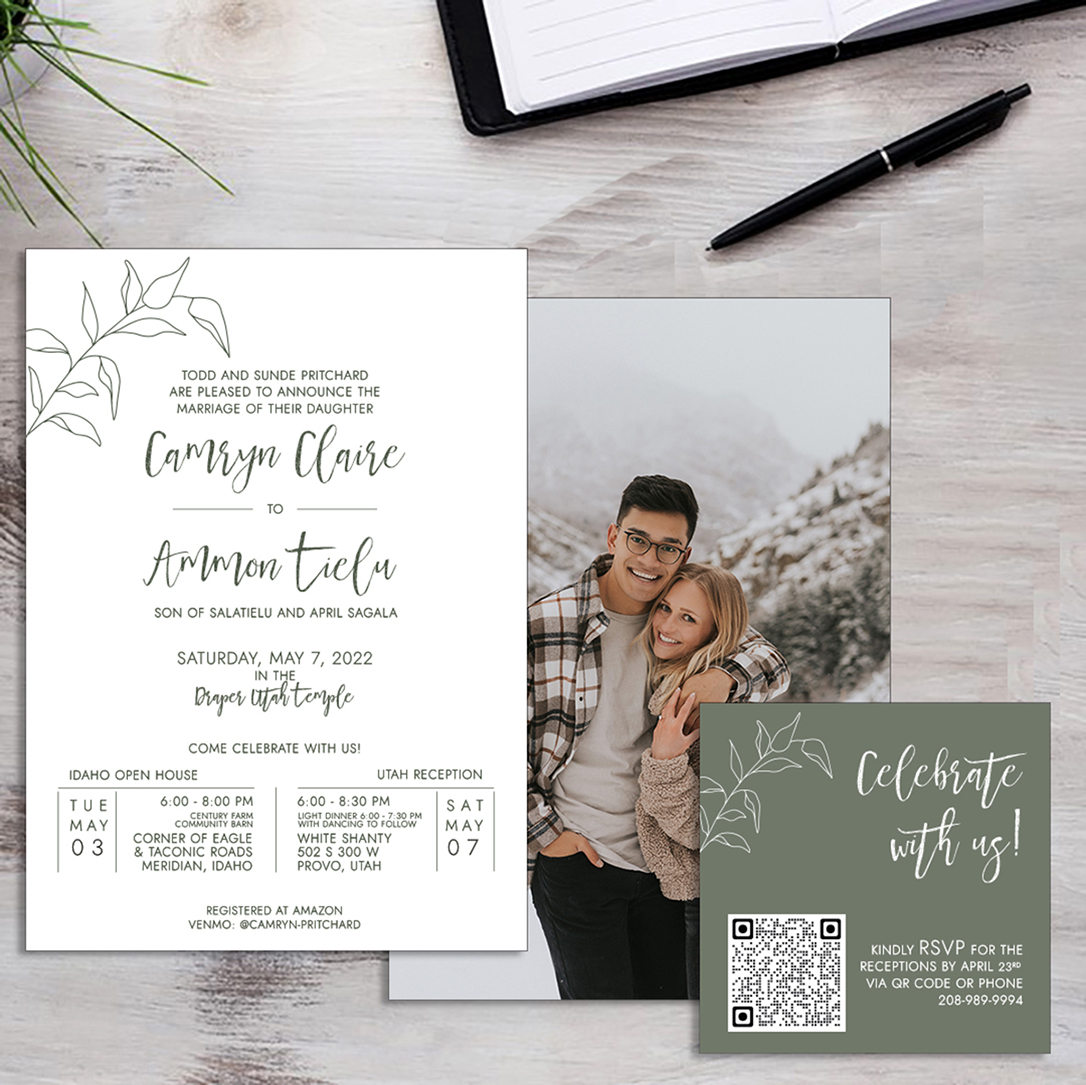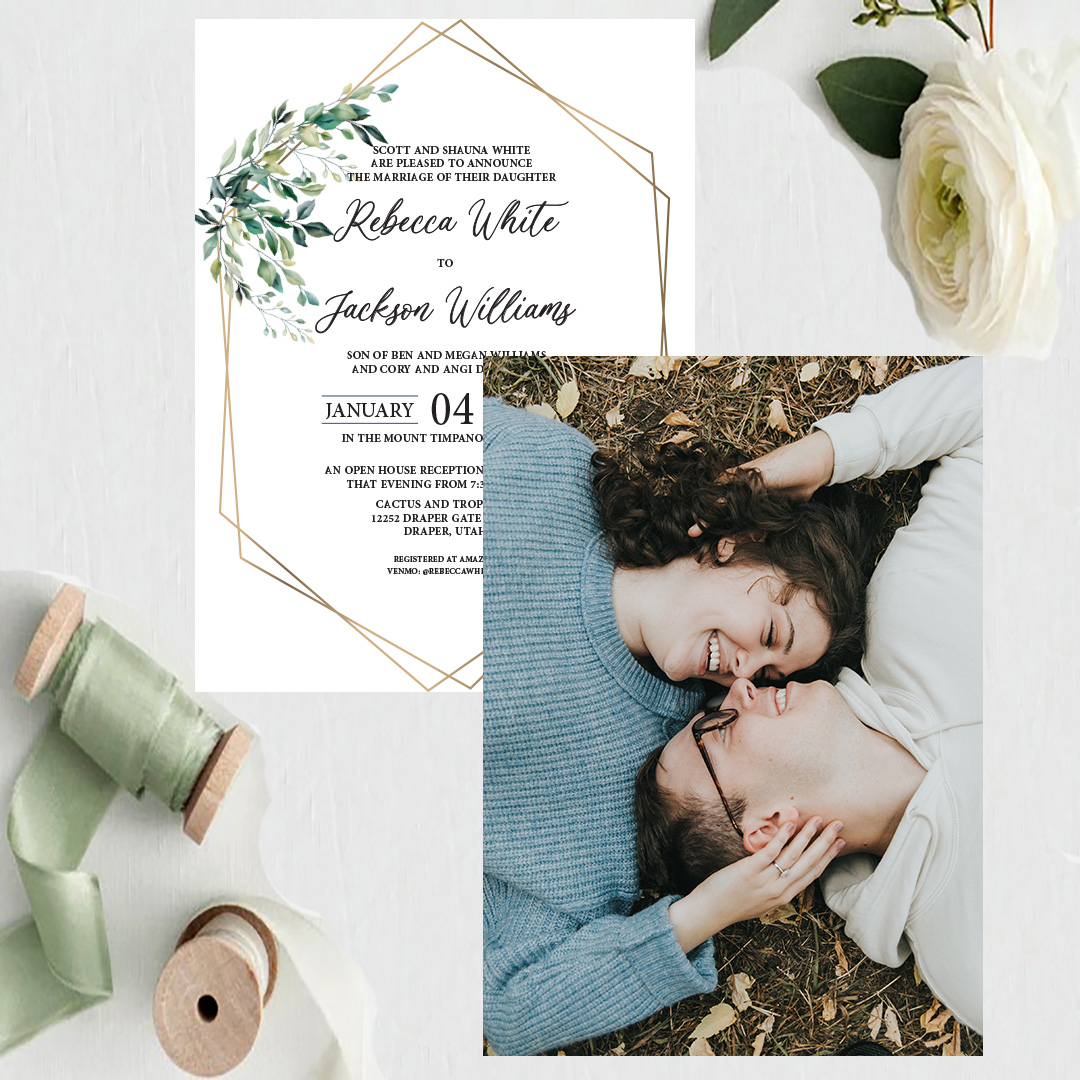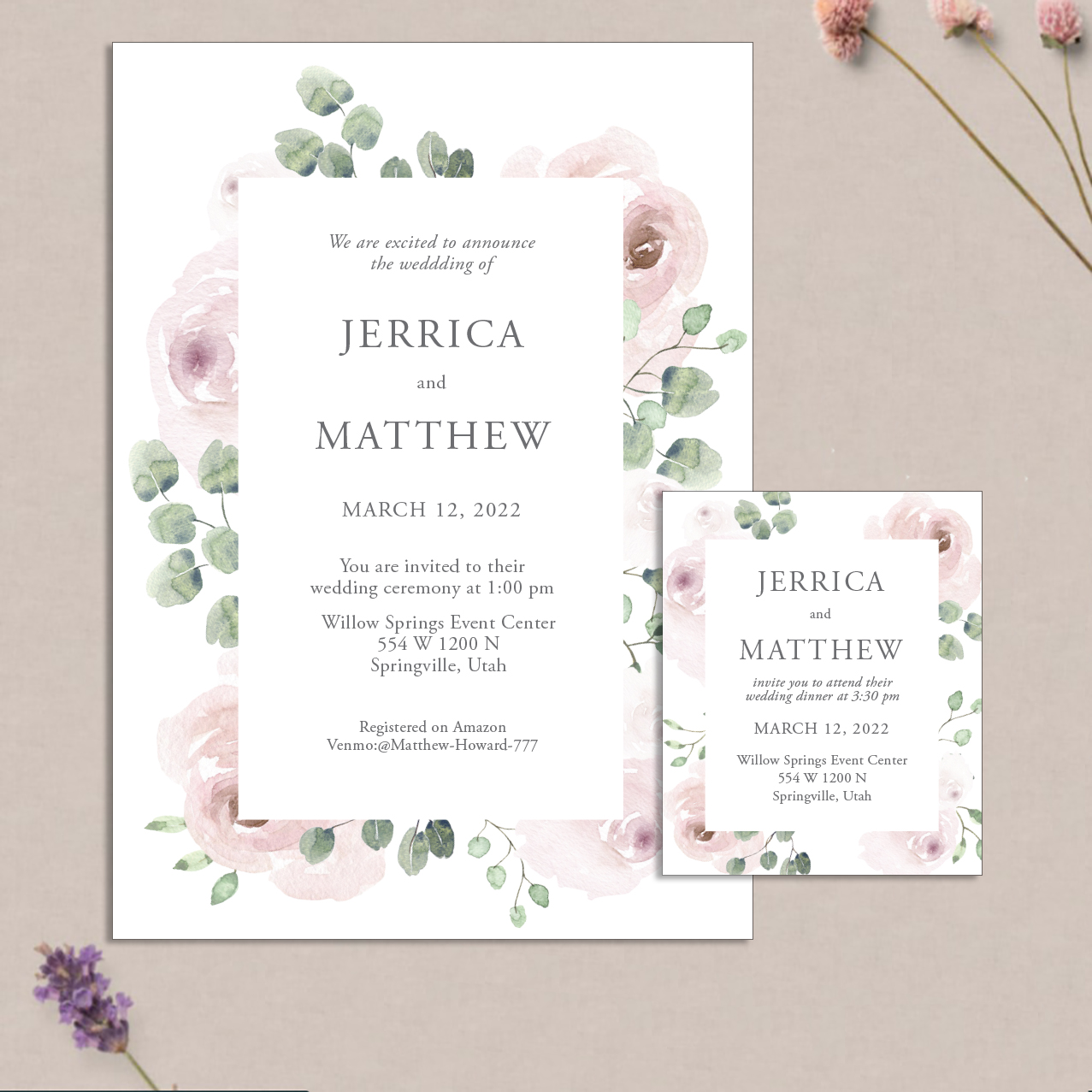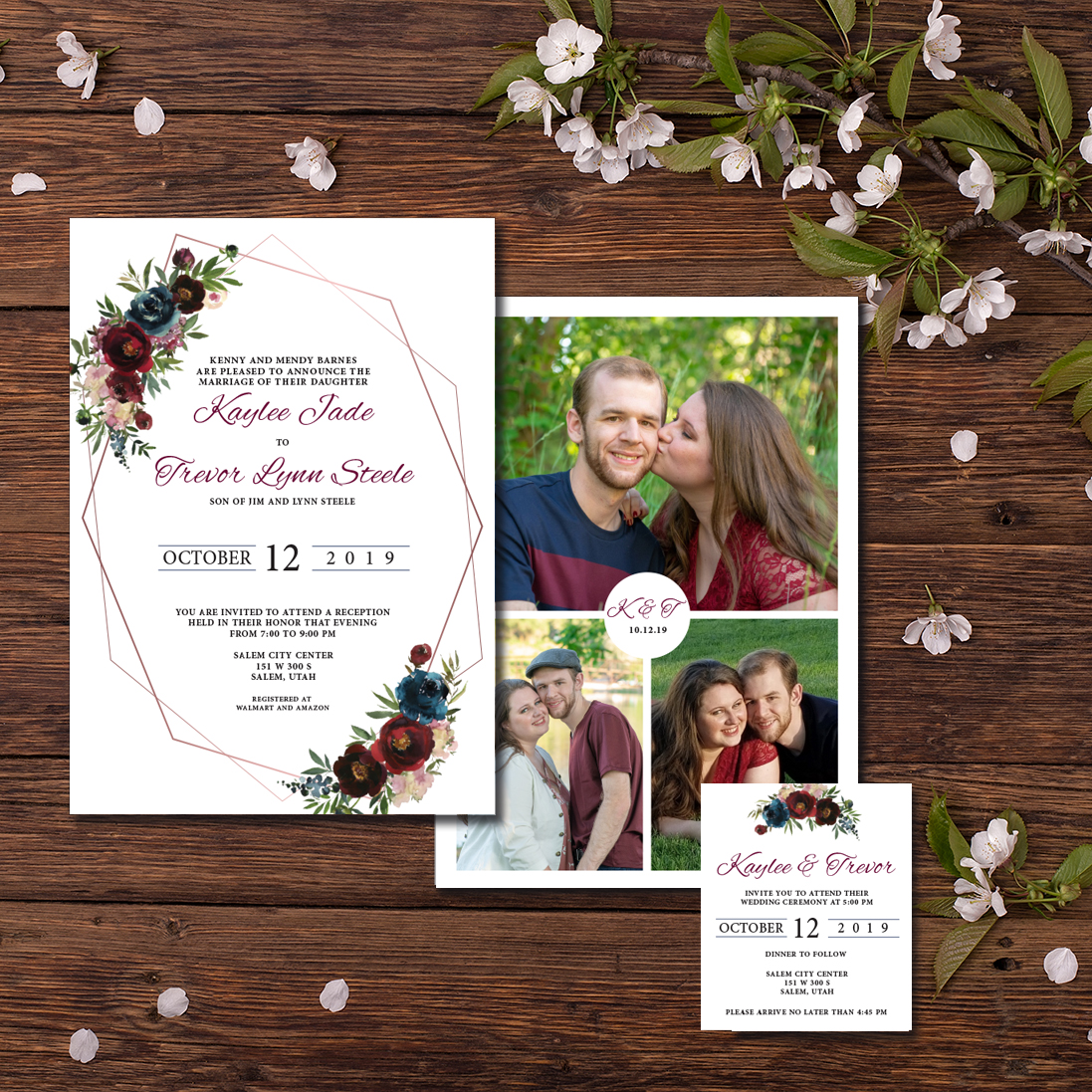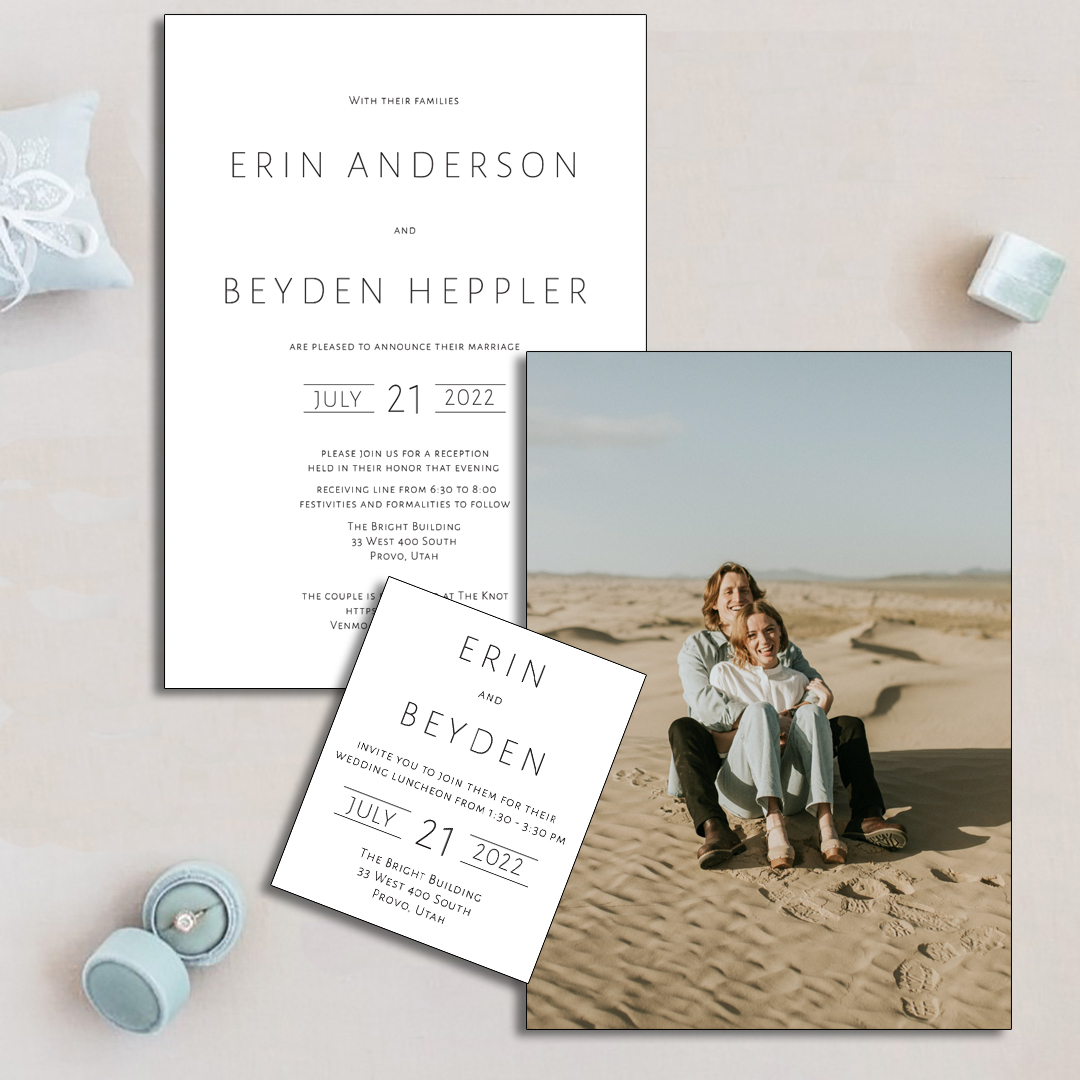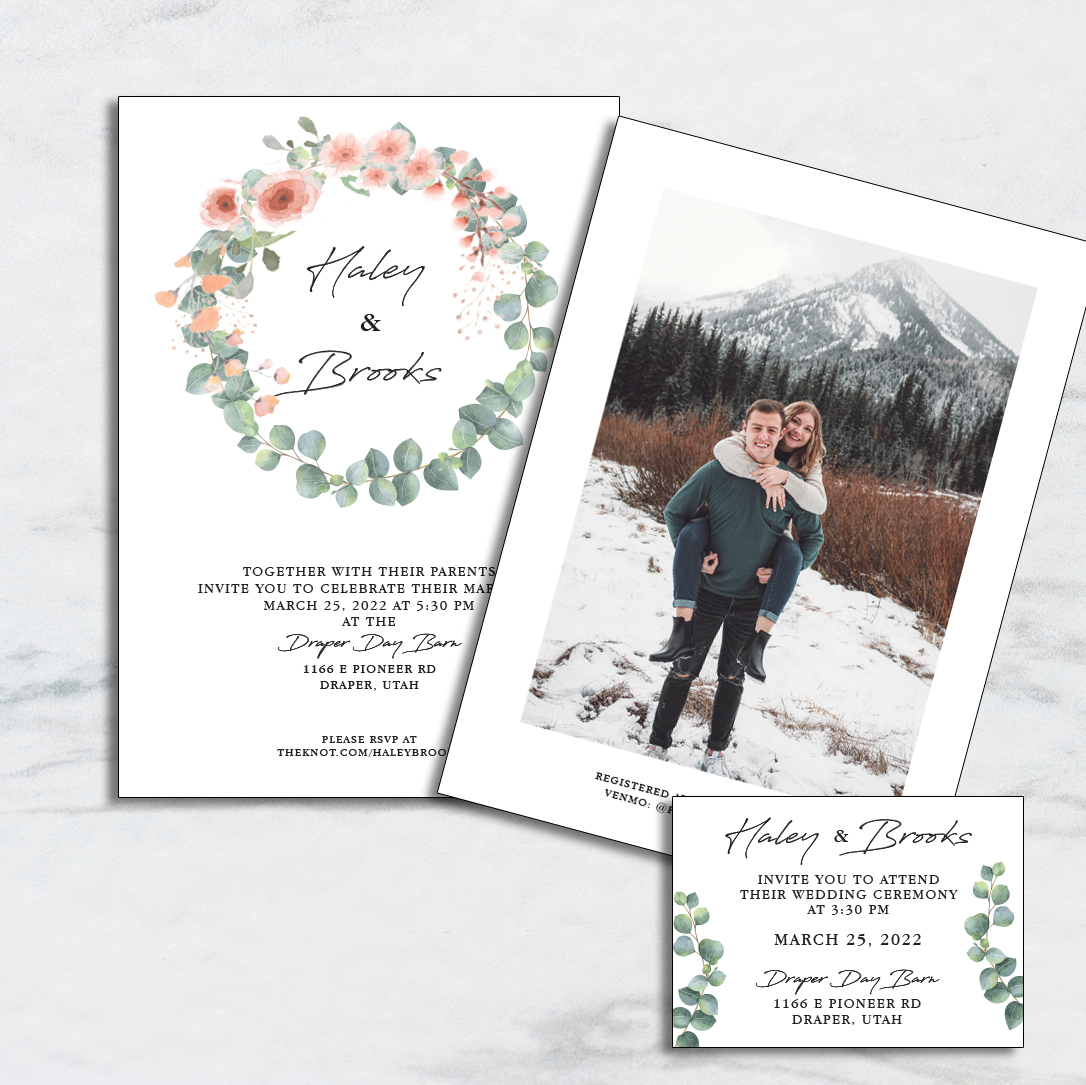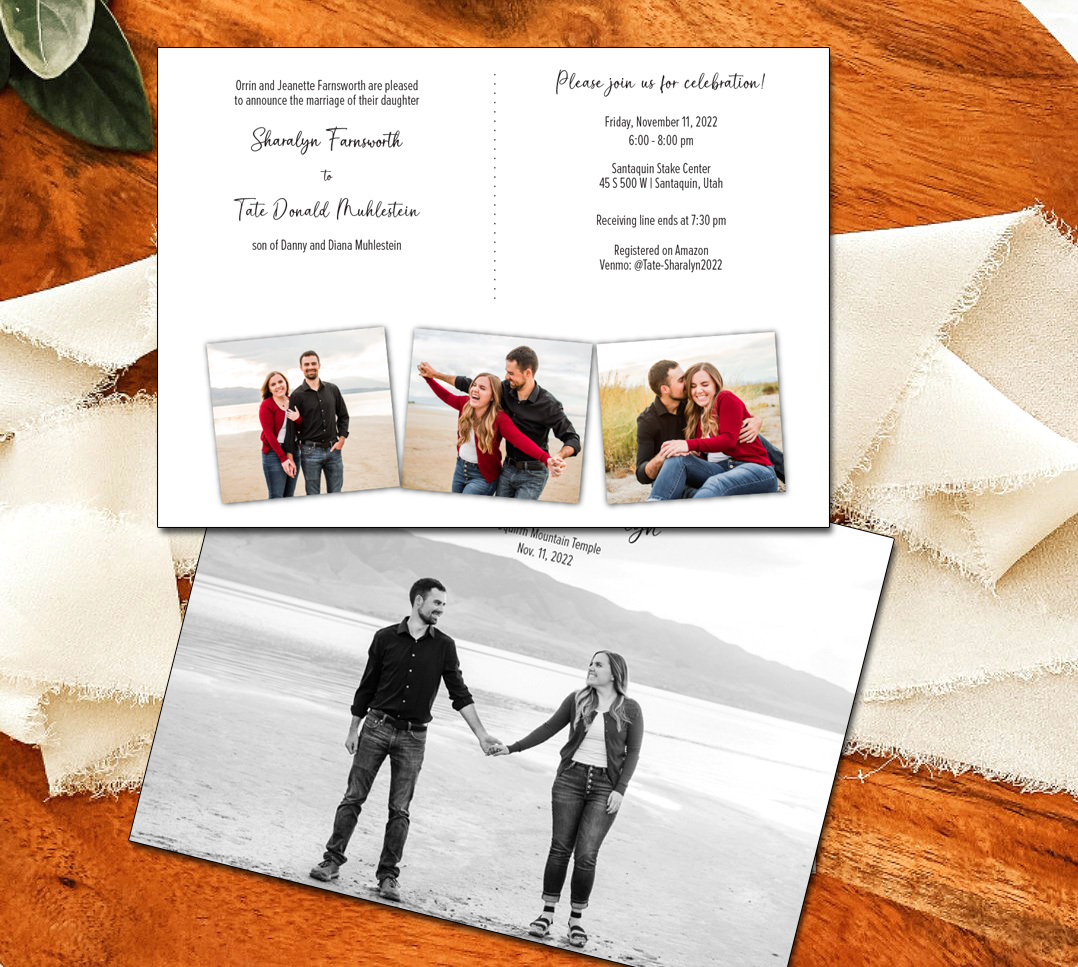Free Envelopes and
Up to 250 Free
Insert Cards
Work One on One
with our
Professional Designer
Customize Colors and
Fonts to Make Your
Invite Perfect for You
Orders Ready within One Business Day Following Approval / Payment
Wedding Invitation Ideas: The Artistry of Wedlock
Modern Wedding Invitation Ideas
Wedding invitations are the first impression that your guests will have of your big day, and it’s essential to get them right. With so many different styles and designs available, it can be challenging to know where to start.
In this article, we’ll take a closer look at modern wedding invitations and how they can set the tone for your special day. are perfect for couples who want to break away from traditional styles and create something unique that reflects their personalities.
These invitations often feature bold typography, clean lines, and vibrant colors that make a statement. If you’re having a mountain or beach theme wedding, you might consider incorporating elements of nature into your modern invitation design.
Red wedding invitations are an excellent choice for couples who want to create a sense of passion and excitement leading up to their special day. A pop of red can add a touch of drama and sophistication to any invitation design.
For example, dusty blue wedding invitations with red accents will create an elegant contrast that will catch your guests’ attention. If you’re looking for classic wedding invitations with a modern twist, emerald green and gold wedding invitations are an excellent choice.
The rich green hue paired with gold accents creates an atmosphere of luxury and style that is sure to impress your guests. Alternatively, blue wedding invitations offer the perfect balance between elegance and simplicity.
Burgundy is another popular color choice for modern wedding invitations as it creates a sense of warmth and depth that is perfect for fall weddings. Royal blue wedding invitations provide a regal touch that’s ideal for more formal weddings where you want to make an impression.
For those who prefer something more bohemian in their wedding invitation ideas, dusty rose or lavender wedding invitations might be just what you’re looking for. These soft pastel shades create a whimsical feel that’s perfect for outdoor garden weddings or rustic barn venues.
Modern invites also afford the ability to include pictures into the final product; even if only through the medium of wedding invitations with pictures. Moreover, black and gold or black and white wedding invitations are always a stylish choice that will never go out of fashion.
Sage green wedding invitations have become increasingly popular in recent years as they provide an understated elegance that is perfect for those seeking a serene and tranquil ambiance for their big day. Modern wedding invitations offer an endless array of design possibilities to the creative couple seeking to create a unique experience for their guests.
From bold typography and vibrant colors to soft pastels and muted tones, there’s something to suit every couple’s style. Whether you’re planning on having an intimate gathering or a grand celebration, your invitation sets the tone for what’s sure to be one of the most unforgettable days of your life.
Elegant Wedding Invitation Ideas
For couples who want to set the tone for a luxurious wedding, elegant wedding invitations are the way to go. These invitations often incorporate classic design elements like flourishes and filigree paired with clean typography to create a refined look.
Black and white wedding invitations are perennially popular for an elegant affair, but there are plenty of other color options that can also be sophisticated. One unexpected option is light blue wedding invitations.
Paired with white or ivory paper and perhaps a touch of silver foil, light blue creates a serene and polished look that’s perfect for a spring or summer event. Blue wedding invitations in general can be very eye-catching, but it’s important to choose the right shade.
Royal blue wedding invitations can be quite bold, while navy blue has more of a traditional feel. Sage green wedding invitations have become increasingly popular in recent years as well; they have an organic elegance that complements outdoor weddings particularly well.
don’t necessarily need to be all about formal design elements either – they can also incorporate playful touches like incorporating photos into the design. Wedding invitations with pictures of the couple are particularly charming, and can showcase engagement photos or snapshots from their relationship together.
For black tie weddings where more dramatic wedding invitation ideas may be preferred, red and black wedding invitations or black and gold wedding invitations can make quite an impression. For couples who want something truly unique, consider working with a designer to create emerald green and gold wedding invitations that pair rich jewel tones with metallic accents.
Rose gold is another trendy option – dusty rose weddings have become increasingly popular in recent years as well – paired with clean typography for maximum impact. No matter what their style preferences may be, there’s sure to be an elegant invitation suite out there that will perfectly suit any couple planning their dream day!
Simple Wedding Invitation Ideas
When it comes to wedding invitations, simplicity can often be the most elegant choice. can still be beautiful and stylish without being too flashy or over-the-top.
Here are some ideas for creating simple wedding invitations that will still make a big impact. One option for a simple wedding invitation is to stick with classic colors and designs.
Black and white wedding invitations are always timeless and sophisticated, while navy blue and light blue wedding invitations can add a touch of subtle color. You could also opt for traditional designs like calligraphy or cursive fonts, which give an elegant touch without being too showy.
Another way to keep your wedding invitations simple is to use minimal graphics or patterns. This could mean using a single graphic element like a rose gold border or small floral details.
Alternatively, you could choose a solid color background with minimalist lettering in white or black font. By keeping the design clean and understated, you create an effortlessly chic invitation.
For couples who prefer more modern styles but still want their wedding invitations to be simple, there are plenty of options as well. Geometric shapes in neutral shades like sage green or dusty blue can create a contemporary look while maintaining simplicity.
Alternatively, you might consider wedding invitation ideas using bold typography in black and red for something more eye-catching. If you’re looking for an easy way to personalize your simple wedding invitation design without adding too much visual noise, consider adding your own photo as the focal point of the invite.
Wedding invitations with pictures are becoming more popular among couples who want something truly unique; they allow you to showcase your relationship through images while keeping the overall look clean and straightforward. If you’re on a tight budget but still want stunning invites that won’t break the bank, quick wedding invitations under $1 per piece might be worth considering!
These offer great value while not sacrificing quality; they’re perfect if you’re planning on inviting lots of guests but don’t want to spend too much money. Whatever your preference, remember that simple wedding invitations can be just as impactful as more elaborate designs; it all depends on your personal taste and the style of your event.
Photo Wedding Invitation Ideas
When it comes to creating wedding invitations, many couples choose to feature their own photographs on their invites. are a great way to personalize your wedding stationery and give your guests a glimpse into your lives as a couple.
One popular style of photo wedding invitation is the classic black and white design. This timeless look can be achieved by taking a romantic photo of the couple in black and white or by choosing an elegant font that complements the photograph.
Another option is to create a red and black wedding invitation that features the couple’s photograph, adding some drama and flair to the design. For couples looking for something more colorful, light blue or dusty blue wedding invitations can be paired with a photo of the couple at their favorite beach or seaside location for a stunning beach theme wedding invitation.
Sage green wedding invitations work well with photos taken in nature, such as in front of mountains or trees, while emerald green and gold wedding invitations could feature photos taken in elegant garden settings. Boho weddings are becoming increasingly popular, so it’s no surprise that boho-themed photo wedding invitations are also on-trend.
For these wedding invitation ideas, opt for photos that showcase free-spirited moments such as dancing barefoot on the beach or playing music together beneath swaying trees. If you’re looking for something more dramatic, consider using black and gold wedding invitations featuring bold images of the couple set against dark backgrounds.
This combination is perfect for formal evening weddings with lots of candlelight. Burgundy wedding invitations can also make an elegant statement when combined with richly colored photographs.
Rose gold is another trendy color scheme that works well with photo invites. A dusty rose background alongside white script font would pair beautifully with images of the happy couple basking in golden sunlight outside.
Royal blue or navy blue background colors work well too, especially if your engagement photos were taken near water sources such as lakes or rivers. There are many ways to incorporate photographs into your wedding invitations.
From classic black and white designs to boho-themed invites, the possibilities are endless. By allowing your personal style and relationship to shine through, you can create unique photo wedding invitations that will be cherished by both you and your guests for years to come.
Traditional Wedding Invitation Ideas
When planning a wedding, couples often want to keep traditions alive, even when it comes to their wedding invitations. are timeless and elegant, and they never go out of style.
If you’re opting for a more formal or classic wedding, a traditional invitation is the perfect fit. Classic Wedding Invitations
For those who want to stick with tradition, classic wedding invitations are the way to go. These invites typically feature formal wording and calligraphy-style fonts in black ink on white or cream paper.
The design is simple yet sophisticated, with no frills or fancy embellishments. Black and White Wedding Invitations
If you’re looking for something understated yet still elegant, black and white wedding invitations are always a safe bet. This timeless color combination works well with any style of wedding theme from beach theme weddings to mountain weddings.
Choose from delicate floral motifs or chic geometric patterns for a touch of personality. Navy Blue Wedding Invitations
Navy blue has become increasingly popular in weddings over the past few years because it’s versatile and adds depth to any color scheme. Navy blue wedding invitations are no exception – they’re stylish and sophisticated without being too stuffy.
Burgundy Wedding Invitations Burgundy is another popular color choice that adds warmth and richness to your invitation suite.
Burgundy paired with gold foil makes for an especially regal look that’s perfect for a fall or winter wedding. Red Wedding Invitations
For couples who want their invitation to make a statement, red wedding invitations are bold and daring choices. Whether it’s deep reds or brighter reds like coral that fit your style best these types of designs will look great with pictures included in them.
Traditional wedding invitations stand the test of time because they evoke elegance, sophistication and formality all at once while still being relevant today. With different colors such as navy blue burgundy or even red there’s always something for everyone.
Vintage Wedding Invitation Ideas
are perfect for couples who want to bring a touch of old-world charm to their wedding day.
These wedding invitation ideas are timeless and elegant, and they can set the tone for a classic and sophisticated event. Whether you’re planning a vintage-inspired wedding or simply want an invitation that is unique and beautiful, there are many options to choose from.
One popular option for vintage wedding invitations is to use muted colors like navy blue, light blue, lavender or dusty blue. These shades create a soft and romantic look that is perfect for a vintage-themed event.
You can also opt for royal blue or rose gold if you want something that has a bit more sparkle. Another option when it comes to vintage wedding invites is to use burgundy as the main color.
This rich shade creates an air of luxury and sophistication that pairs perfectly with antique lace details and calligraphy font styles. For those who prefer classic elegance, black and white wedding invitations are always in style.
This timeless combination creates an air of sophistication that is ideal for formal events. If you’re planning a beach-themed wedding, then consider using ocean blues or sandy browns in your invites.
A beautiful watercolor design featuring seashells or starfish will create an inviting seaside feel. Mountain weddings offer the opportunity to use earthy-toned greens in your invitation color palette such as sage green, emerald green which can be combined with gold accents creating an outdoor atmosphere with added elegance.
Boho weddings offer the chance to experiment with bold patterns like mandalas or paisley prints in warm colors like burgundy or deep purple. Mixing them with geometric shapes could add even more interest while keeping it cohesive.
You may also use pictures on your invite if you have any previous photos together as this adds an element of personalization without making it too overwhelming. Vintage-inspired invites offer endless possibilities when it comes creating unique stationery on your big day!
Rustic Wedding Invitation Ideas
are a great way to bring the beauty of nature and the charm of rural living into your special day. These invitations can feature a variety of design elements that evoke a sense of warmth and relaxation, such as wood grains, floral patterns, or natural colors like brown, green, and tan. One great option for rustic wedding invitations is to feature scenic images of mountains or other natural landscapes.
For example, you could include an image of a snow-capped mountain range or a tranquil forest in your invitation design. This type of invitation would be perfect for couples who are planning an outdoor mountain wedding in the summer or fall.
Another popular option for rustic wedding invitations is to incorporate reds and blacks into the design. This color combination can create a bold and striking invitation that will stand out from more traditional designs.
You could also choose black and white wedding invitations for a classic look that still captures the essence of rustic charm. For couples who want to add some elegance to their rustic theme, royal blue or black and gold wedding invitations might be the perfect choice.
These colors can create an air of sophistication while still maintaining the cozy ambiance that makes rustic weddings so special. If you’re going for a beachy feel, then light blue wedding invitations could be just what you need.
These invites often feature images of shells or other beachy elements that guests will instantly recognize as belonging to this specific theme. And if boho is more your style, lavender wedding invitations will fit your aesthetic perfectly!
Emerald green and gold are another beautiful combination that work well together on dusty rose backgrounds. Sage green is also very popular in rustic weddings as it captures nature’s tranquility perfectly with its earthy tones.
Burgundy adds richness and depth, which when combined with classic floral designs make breath-taking Rustic Wedding Invitations. Black & Red Wedding Invitations are bold statements seen often on Halloween weddings but also make perfect winter wedding invitations.
No matter which wedding invitation ideas you choose, rustic wedding invitations are a great way to convey a sense of warmth and relaxation to your guests while getting them excited for your special day. And don’t forget, you can always add pictures to your wedding invitations – they’re perfect for capturing the love and excitement of two people about to say “I do”!
Classy Wedding Invitation Ideas
If you’re looking for something timeless and elegant for your wedding invitations, then a classy design might be just what you’re after. are ideal for couples who want to create a sophisticated atmosphere for their special day.
Whether you’re planning an extravagant ballroom affair or an intimate garden wedding, there are plenty of classy invitation designs to choose from. One popular color scheme for classy wedding invitations is emerald green and gold.
This combination exudes luxury and sophistication, making it perfect for formal weddings. Burgundy is another great option that adds depth and richness to your invites.
Paired with metallic accents like gold or rose gold, burgundy can create a truly luxurious look. For couples who prefer a more dramatic feel, red and black wedding invitations are also a great choice.
This color combination creates a bold statement that’s perfect for modern weddings with an edgy twist. Another stunning option is rose gold wedding invitations that add warmth and romance to your invitation suite.
If you want to add some personal touches to your invites, why not consider using pictures? Wedding invitations with pictures are becoming increasingly popular because they allow couples to showcase their personalities while still maintaining an elegant aesthetic.
Navy blue wedding invitations can also look classy when paired with metallic accents like silver or gold. Royal blue is another great color that oozes sophistication while still being bright and fun.
Classic designs in shades of lavender or sage green can also work really well if you’re looking for something subtle yet timeless. For those planning mountainous outdoor weddings, mountain-themed invites incorporating natural elements such as trees or mountains would be ideal alternatives alongside rustic papers like kraft paper.
Alternatively, beach-themed invites in seafoam green hues with shells would be perfect choices in midsummer beach weddings alongside boho styled designs. No matter which style you choose, remember that the key to creating truly classy wedding invitations is attention to detail; everything from the fonts to the paper quality should be meticulously chosen to ensure that your invites look and feel luxurious.
Custom Wedding Invitations Ideas
If you’re looking for unique wedding invitations, then custom wedding invitations are your go-to choice. With custom invitations, you can have the freedom to choose the specific design details that you want for your special day.
Whether it’s blue wedding invitations with an ocean theme or classic wedding invitations with a modern twist, there are numerous possibilities when it comes to customizing your wedding invitation. If you’re planning a mountain wedding, consider creating dusty rose wedding invitations with a natural and rustic feel.
You could add images of the mountains or pine trees to give your guests a glimpse of what is in store for them. If you want something more formal and elegant, then black and gold wedding invitations might be just what you need.
These invitations can feature gold foil accents paired with black lettering resulting in stunning contrast. Are you into boho chic?
Don’t hesitate to try out boho wedding invitations that offer plenty of floral patterns and earthy tones such as rose gold or dusty blue colors. Additionally, if traditional is more your style, then opt for black and white wedding invitations with elegant font styles that provide simplicity but still impress your guests.
Adding personal photos to your custom invitation takes them up another level! If capturing moments is essential to your event, consider getting photo wedding invitations made by including pictures that represent each stage of the relationship.
This way guests will have something tangible to remember forever! Creating personalized invites allows couples to make their day even more memorable while setting the tone for what’s ahead on their special day!
Customized wedding invitation ideas such as lavender or sage green ones provide delightful pops of color reflecting joyfulness while inviting others into their happiness. No matter what design direction couples decide on- beach theme or even red and black; unique creations are guaranteed when opting for customized invites- offering everlasting memories!
RSVP Wedding Invitation Ideas
RSVP stands for “Répondez s’il vous plaît,” which means “Respond, if you please” in French.
RSVP cards are necessary to know how many people are coming to your wedding so that you can finalize the number of guests and make sure everything is just perfect. When it comes to RSVP wedding invitations, there are a few things to consider: what information needs to be included in the invitation, how to make it clear for guests that they need to RSVP, and what kind of response cards or other methods can be used.
To start with, when you design your RSVP wedding invitations, make sure that you have all the important information included. This includes the date and time of the wedding ceremony and reception, dress code (if any), directions to the venue(s), contact information for guests with questions or concerns about attending or transportation arrangements.
You may also want to consider including a brief note about what kind of festivities will occur at each location. It’s important when creating your RSVP cards that they are clear and easy-to-follow.
Make sure that it is obvious on the card whether or not someone needs to respond by writing yes/no/maybe/etc., along with providing instructions on how they should respond: by phone call/email/website/etc. The more accessible your response options are (such as offering an online option), the more likely people will be able to respond promptly.
When designing invitation cards we recommend choosing colors like navy blue wedding invitations or black and white wedding invitations for formal events. Alternatively, dusty rose wedding invitations or light blue wedding invitations provide a comfortable feeling for more informal events such as beach theme weddings or mountain weddings.
Additional great idea wedding invitation ideas are personalized photo responses where you include a picture with your partner on one side of your response card making it both unique and memorable. Additionally, using boho-style designs or emerald green and gold color schemes can make this type of card look aesthetically pleasing.
RSVP wedding invitations are an essential part of planning your wedding. They help you keep track of who is attending and also allow you to make arrangements accordingly.
Make sure to include all the necessary information on your RSVP cards and provide clear instructions for how guests should respond. Whether you choose classic wedding invitations with more traditional designs or modern ones with unique twists, make sure they fit the theme and tone of your special day.
Unique Wedding Invitation Ideas
When it comes to planning a wedding, couples often strive to make their special day as unique and memorable as possible. And what better way to set the tone for a one-of-a-kind celebration than through unique wedding invitations?
These unconventional invitation designs can capture the essence of your relationship and give guests a glimpse into the style and ambiance of your upcoming nuptials. For couples dreaming of a beach-themed wedding, beach theme wedding invitations are an excellent choice.
Picture this: sandy shores, gentle waves, and a color palette inspired by the ocean. A beach-themed invitation can feature seashells, starfish, or even watercolor illustrations of palm trees.
Consider using shades of blue or sandy beige for an authentic coastal feel. If you’re looking for something regal and glamorous, emerald green and gold wedding invitations exude opulence like no other.
The combination of rich emerald green with luxurious gold accents creates an air of sophistication and elegance. Whether it’s in the form of intricate foil stamping or shimmering envelopes sealed with wax seals, these invitations will surely impress your guests.
For those seeking a touch of romance and femininity, rose gold wedding invitations provide an exquisite option. Rose gold has become increasingly popular in recent years due to its delicate pinkish hue that adds a subtle hint of glamour.
From foil-stamped floral motifs to elegant calligraphy fonts printed on blush-colored cardstock, these invitations ooze romance from every detail. If you prefer something more traditional but still want a unique twist, consider blue wedding invitations.
Shades like royal blue can add depth and vibrancy to your invite while maintaining a classic aesthetic. A combination of elegant fonts engraved on textured paper is sure to evoke timeless charm that will leave lasting impressions on your recipients.
Alternatively, if you’re aiming for a bold and daring look for your big day, black and red wedding invitations might be just what you need. This color scheme exudes drama and passion, making it perfect for couples who want to make a statement.
Opt for engraved black cardstock with striking red accents or bold typography to create an invitation that demands attention. When it comes to unique wedding invitation ideas, the options are endless.
Whether you choose beach theme, emerald green and gold, rose gold, blue, or black and red invitations, remember that these designs should reflect your personality as a couple and set the tone for your special day. Don’t be afraid to let your creativity shine through and think outside the box – after all, it’s your wedding day!
Personalized Wedding Invitation Ideas
When it comes to planning your big day, every detail matters, and your wedding invitations are no exception.
are a fantastic way to add a unique touch that reflects your personality and style as a couple. With endless options available, you can create invitations that perfectly capture the essence of your love story.
One popular option for personalized wedding invitations is incorporating pictures of the happy couple. Imagine sending out emerald green and gold wedding invitations adorned with a stunning photo of you and your partner.
Not only does this add a personal touch, but it also allows your guests to see the love radiating from both of you. For couples looking for a more romantic vibe, dusty blue wedding invitations with soft pastel accents can set the tone beautifully.
These light blue wedding invitations exude elegance and grace while adding a touch of whimsy to the overall design. Adding personalized details such as custom monograms or motifs tied into your love story can make these invitations truly one-of-a-kind.
If you’re planning a classic and timeless affair, black and white wedding invitations are always an excellent choice. The simplicity and sophistication of these invites will instantly captivate your guests while reflecting the elegant theme of your special day.
Consider adding subtle touches like embossed details or intricate calligraphy to elevate these traditional designs even further. For those seeking something bold and dramatic, burgundy wedding invitations make quite an impression.
This deep hue adds depth and richness to any invitation suite, creating an air of opulence that’s hard to resist. Complementing these invites with boho-inspired elements such as dreamcatchers or floral patterns can create an enchanting atmosphere for your guests from the moment they receive their invitation.
Consider wedding invitation ideas for personalized wedding invitations that incorporate nature-inspired themes such as mountain or beach motifs. Sage green wedding invitations bring forth feelings of tranquility and harmony, perfect for an outdoor mountain wedding celebration.
On the other hand, beach theme wedding invitations in shades of sandy beige or azure blue can transport your guests to a tropical paradise, setting the tone for a joyous seaside affair. Personalized wedding invitations allow you to infuse your unique style into every aspect of your wedding planning.
Whether you opt for bold colors like rose gold or dusty rose wedding invitations, classic designs like navy blue and gold, or themes that reflect your favorite destinations like mountain or beach weddings, the possibilities are endless. Let your creativity shine through and create invitations that not only announce the details of your special day but also tell your love story in a truly personal way.
Quick Wedding Invitation Ideas
When it comes to planning a wedding, time can sometimes be of the essence. Whether you’re a last-minute planner or simply prefer a quick and efficient process, quick wedding invitations are the perfect solution for getting those essential details out to your guests in a timely manner. With these speedy options, you won’t have to sacrifice style or personalization.
One popular option for expedited wedding invitations is to go digital. Digital invitations allow you to create and send out beautiful designs with just a few clicks.
There are numerous websites and platforms that offer customizable templates, allowing you to choose from a wide range of styles and color schemes. Whether you’re looking for boho wedding invitations, light blue wedding invitations, or even royal blue wedding invitations, you’ll find plenty of options online.
If digital isn’t your preferred method, quick wedding invitation ideas can be pre-made printable wedding invitation kits. These kits typically come with all the necessary materials, including invitation cards and envelopes, as well as access to customizable templates that can be edited on your computer.
With wedding invitation ideas like rose gold wedding invitations, navy blue wedding invitations, or even red wedding invitations available in these kits, you can easily find something that matches your desired theme. For those who want an even quicker solution without compromising on style, consider using fill-in-the-blank wedding invitation sets.
These sets usually come with pre-printed text where you can easily fill in the details of your big day. The designs range from classic black and white wedding invitations to more unique options like dusty rose or black and gold combinations.
Additional time-saving wedding invitation ideas are opting for postcard-style RSVPs instead of traditional reply cards with envelopes. This eliminates the need for assembling multiple pieces and saves on postage costs as well.
Sage green or lavender-themed postcard-style RSVPs can add an extra touch of elegance while simplifying the response process for both you and your guests. If time is of the essence when it comes to sending out wedding invitations, there are several quick options available that still allow for personalization and style.
Whether you choose to go digital, utilize pre-made printable kits, opt for fill-in-the-blank sets, or simplify the response process with postcard-style RSVPs, you can ensure that your invitations reach your guests in a timely manner without sacrificing the overall look and feel of your wedding. From black and red wedding invitations to burgundy or even emerald green and gold combinations, there are numerous designs to suit every couple’s unique taste.
Wedding Invitations Under $1
Planning a wedding can be an exciting and joyful experience, but it can also put a strain on your budget. If you’re looking to save some money on your wedding invitations, fear not! There are plenty of options available that won’t break the bank.
In this section, we’ll explore some creative ideas for wedding invitations under $1. 1. DIY Invitations: One of the most cost-effective options is to create your own wedding invitations.
With a little creativity and some basic crafting supplies, you can design unique and personalized invitations that reflect your style. Consider using printable templates or designing them from scratch using online tools.
You can find affordable cardstock in various colors and textures to give your invitations a professional look without spending a fortune. 2. Digital Invitations: In today’s digital age, online wedding invitations have become increasingly popular.
Websites and apps offer customizable templates that allow you to design beautiful digital invitations with ease. Not only are they budget-friendly, but they also provide the convenience of instant delivery and easy RSVP tracking for your guests.
- Simplicity is Key: Opting for simple wedding invitations can be both elegant and cost-effective. Choose a minimalist design with clean lines or go for classic designs like black and white or navy blue invitations that exude sophistication without breaking the bank.
- Budget-Friendly Materials: When selecting materials for your affordable wedding invitations, consider opting for less expensive options such as lighter-weight cardstock or recycled paper. These materials not only help reduce costs but also support eco-friendly practices.
- Bulk Ordering: If you have a large guest list, purchasing in bulk can significantly reduce the cost per invitation. Many printing companies offer discounts when you order large quantities.
Just make sure to double-check all information before placing the order to avoid any mistakes that could lead to costly reprints. Remember, while it’s essential to stick to your budget, don’t compromise on quality or style when it comes to your wedding invitations.
With a little bit of research and creativity, you can find affordable options that reflect your personality and set the tone for your special day. Whether you choose to go the DIY route, explore digital options, or embrace simplicity, there are plenty of ways to create beautiful wedding invitations under $1.
By thinking outside the box and considering alternative materials and designs, you can save money without sacrificing style. So go ahead and start browsing through templates or gathering crafting supplies – your budget-friendly wedding invitations await!
Conclusion
When it comes to wedding invitation ideas, the possibilities are truly endless. Whether you prefer modern and sleek designs or elegant and timeless classics, there is a style out there that will perfectly capture the essence of your special day.
From simple and understated invitations to ones adorned with beautiful photographs, you can find something that speaks to your unique taste and personality. If you’re dreaming of a beach-themed wedding, consider light blue wedding invitations that evoke the serene beauty of the sea.
For a glamorous affair, emerald green and gold wedding invitations will add a touch of opulence to your celebration. Black and white wedding invitations scream sophistication, while navy blue wedding invitations exude elegance.
If you’re planning a boho-chic wedding in the mountains, think wedding invitation ideas for rustic-inspired designs with earthy tones like dusty rose or lavender. And for those looking for a touch of glamour with a modern twist, rose gold or black and gold wedding invitations will make a bold statement.
No matter which wedding invitation ideas you choose, don’t forget to personalize your invites with details that reflect your love story. Wedding invitations with pictures are not only unique but also allow your guests to feel more connected to your journey as a couple.
Add little touches like custom monograms or wax seals for an extra dose of charm. Remember that wedding invitation ideas should align with your overall theme and color scheme.
For instance, if you’ve chosen burgundy as one of your main colors, consider incorporating it into your invites for a cohesive look. Red and black wedding invitations can lend an air of passion and drama to any celebration.
In the end, what matters most is that your wedding invitation sets the tone for an unforgettable day filled with love and joy. So take inspiration from these ideas but don’t be afraid to let your creativity shine through.
Your guests will be thrilled by the first glimpse they get into this magical event – an occasion truly worth celebrating! So go forth and start designing your perfect wedding invitations.
With your unique taste and the right choices, you’ll create an invitation suite that will leave a lasting impression on your guests and set the stage for a truly unforgettable day. Cheers to love, happiness, and a beautiful journey ahead!

